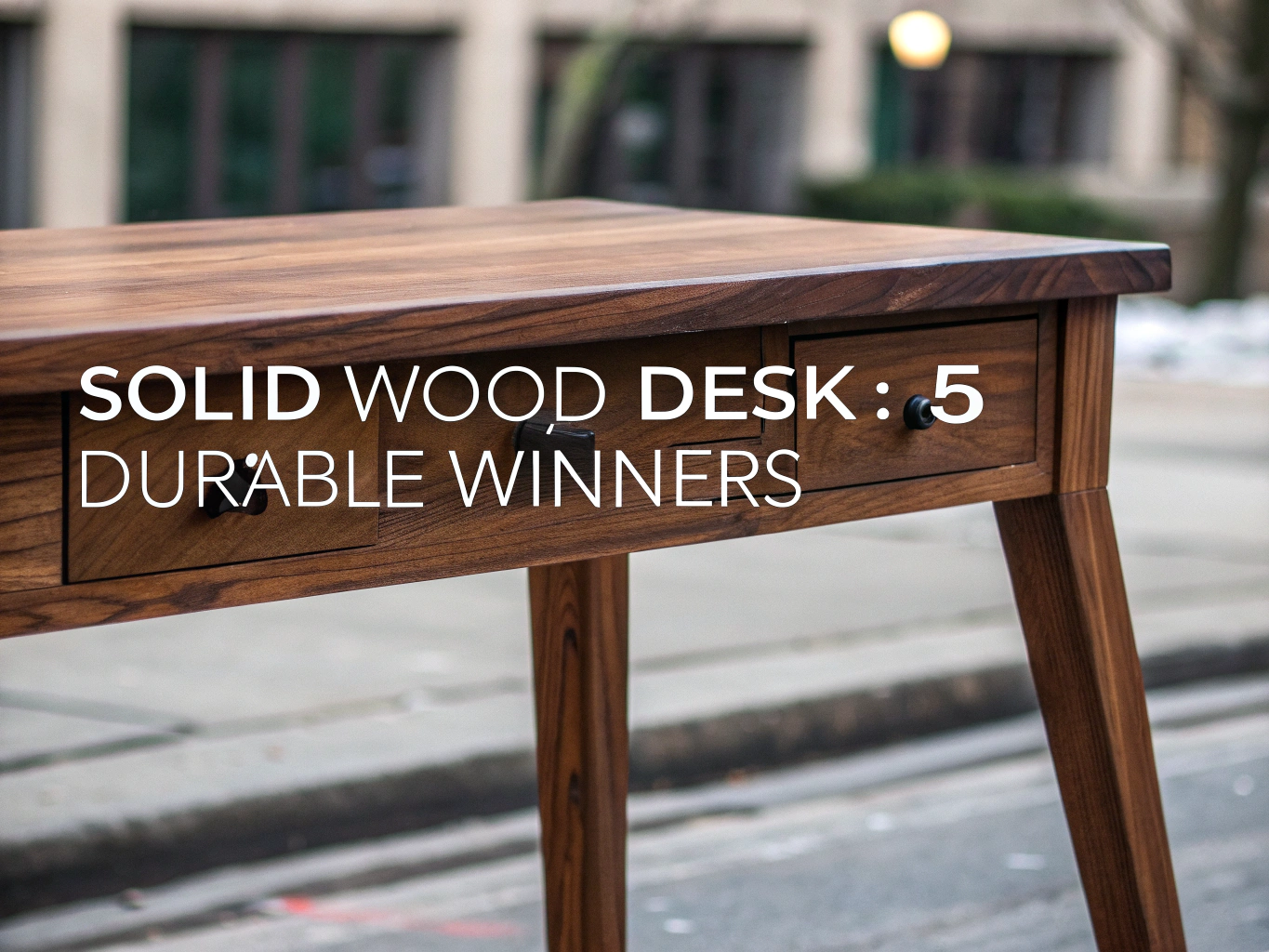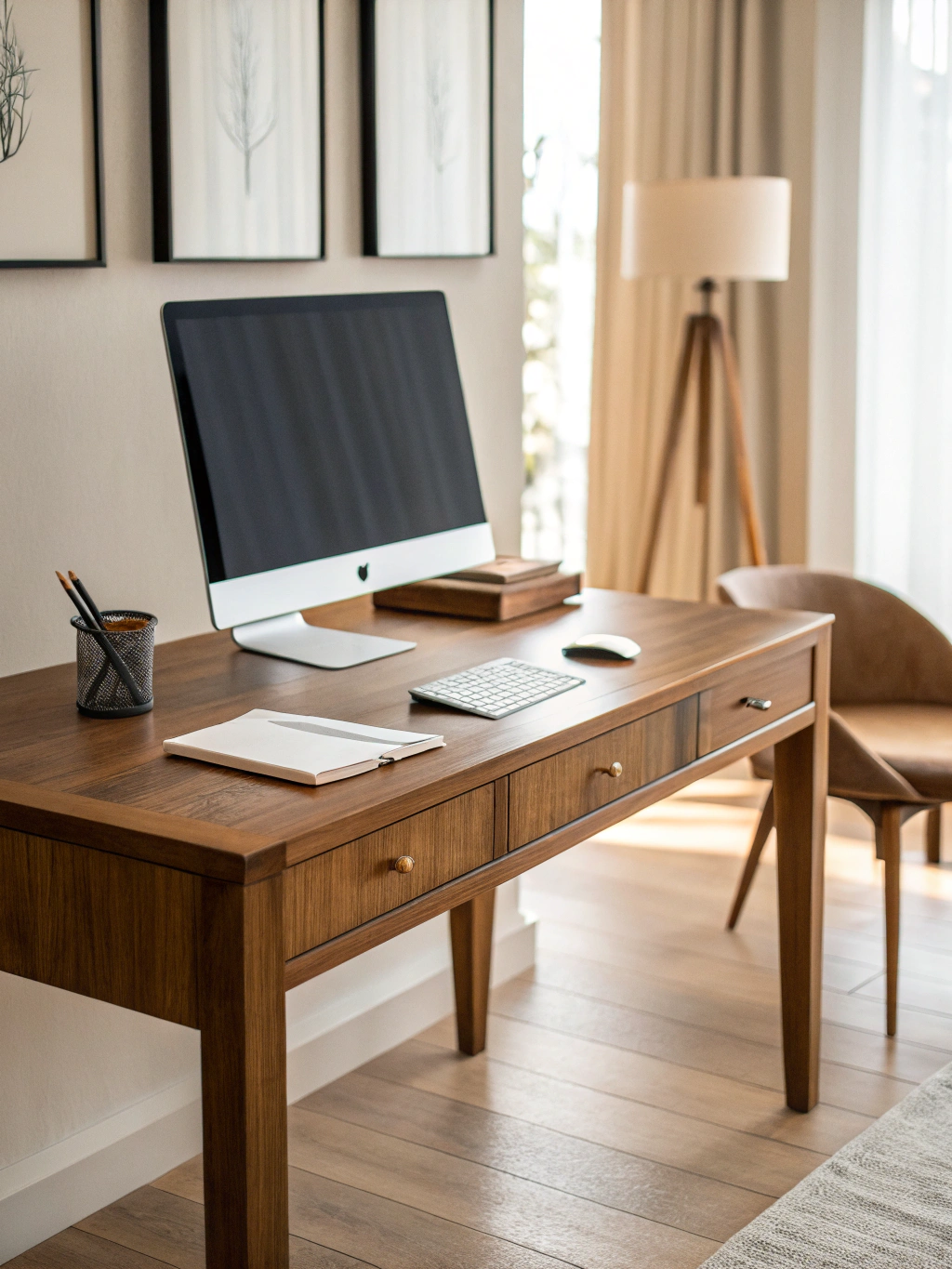
The Ultimate Guide to Solid Wood Desks: 5 Durable Options Worth Your Investment

Have you ever wondered why solid wood desks remain popular despite countless modern alternatives? The answer lies in their unmatched durability and natural character. A solid wood desk brings warmth and authenticity to any workspace while promising years of reliable use.
Whether you need a solid wood writing desk for creative work, a solid wood computer desk for your tech setup, or a spacious solid wood L-shaped desk for a corner office, these furniture pieces offer both beauty and function. The unique grain patterns and rich colors create a workspace that feels both personal and professional – something that manufactured materials simply can’t match.
Table of Contents
Solid wood desks combine classic craftsmanship with practical use for any workspace. They offer great durability that can last for generations with proper care. The natural beauty of wood grain gives each piece a unique character. Solid wood desks are not just functional; they are also statement pieces. They enhance the look of any office environment.
Introduction: Why Choose a Solid Wood Desk
Choosing a solid wood desk for your workspace offers numerous advantages that make it worth the investment. Unlike mass-produced alternatives, these desks provide exceptional durability, often lasting for decades or even generations with proper care. The natural beauty and unique grain patterns mean that no two desks are the same. This adds character to your office space.
Solid wood desks offer remarkable versatility in design options, from traditional executive styles to modern minimalist approaches. They can be customized and restored over time, allowing you to refinish or repair them rather than replace them. This makes them not just furniture but a long-term investment that maintains its value and functionality.

Types of Wood for Quality Desks
The type of wood you select for your desk significantly impacts its appearance, durability, and price. Here are some popular wood varieties that make excellent desk materials:
Oak
Oak remains a classic choice for quality furniture due to its distinctive grain and excellent durability. This lightweight yet sturdy wood has been used in desk construction for centuries, according to UpDown Desk. Oak desks gain character as they age. They can be finished in many ways, like natural oil or paint. Its ability to hold screws and nails firmly makes it ideal for desks that require assembly or additional fixtures.
Walnut
For those seeking premium options, walnut offers rich dark coloration and superior strength. This heavyweight wood features straight, open grains that create visually striking desk surfaces. Walnut’s natural durability makes it perfect for solid wood computer desks that need to support heavy equipment. Walnut is more expensive than other options. However, its beauty and long life make it a good choice for a high-end desk.
Birch
Birch provides an excellent middle-ground option with its fine-grain patterns and visual appeal. Though technically not classified as a hardwood, birch offers impressive density that ranks between lighter maple and heavier walnut. This makes it ideal for creating stable, attractive types of wood for furniture, including desks. Birch can be finished to highlight its natural beauty or stained to mimic more expensive woods.
Other Popular Wood Varieties
Beyond these common options, many other wood types make excellent desks:
- Cherry: Known for its warm reddish tones that deepen with age
- Maple: Offers a light, clean appearance with subtle grain patterns
- Ash: Features an excellent strength-to-weight ratio with distinctive grain
- Pine: Budget-friendly option with a rustic, casual appearance
- Cocobolo: Exotic hardwood with stunning color variations for luxury desks
Top 5 Solid Wood Desks Worth Considering
1. Executive-Style Solid Wood Desks
Executive desks make a powerful statement in any professional setting with their substantial size and commanding presence. Here are some top options in this category:
These executive-style desks feature premium construction with ample workspace for spreading out documents and multiple monitors. The large surface area offers space for work and client meetings. The solid wood construction makes it stable and long-lasting. In professional settings, these desks convey authority and success while providing practical functionality for daily tasks.
When choosing an executive desk, think about the drawer layout, leg style, and wood finish. These should match your office décor. Many executive models incorporate traditional elements like carved details or leather inlays while maintaining modern functionality for today’s technology needs.
2. Space-Efficient Solid Wood Desks for Home Offices
For home offices with limited space, these compact yet functional solid wood desks offer the perfect solution:
These space-efficient designs maximize functionality without overwhelming smaller rooms. Many feature clever storage solutions like built-in shelving, keyboard trays, or cable management systems to keep your workspace organized. Despite their compact footprint, these desks maintain the quality and durability of solid wood construction.
Style remains important even in smaller spaces, with these desks offering clean lines and versatile finishes that complement home décor. Ergonomic considerations like proper height and adequate knee clearance ensure comfort during long work sessions. A quality desk pad can further enhance the functionality of these compact workspaces.
3. High-End Adjustable Solid Wood Desks
The marriage of traditional craftsmanship with modern ergonomics has created a new category of premium adjustable solid wood desks:
- Fully Jarvis Hardwood Standing Desk: This desk comes in bamboo, maple, and walnut. It has quiet motors and can lift up to 350 pounds. Height ranges accommodate users from 5’0″ to 6’9″, making it versatile for various body types.
- Uplift V2 Solid Wood Standing Desk: These desks have one-inch-thick solid wood tops. They feature hand-finished edges in walnut, cherry, and pheasantwood. According to Uplift Desk, each desktop is uniquely crafted to highlight the natural grain patterns.
While these adjustable options represent a significant investment, they offer the health benefits of standing desks without sacrificing the beauty and durability of solid wood construction.
4. Solid Wood Desks with Optimal Storage
A solid wood desk with drawers provides the perfect balance of workspace and organization. These desks feature thoughtful storage configurations to keep your work area tidy and efficient.
Different drawer configurations serve various needs:
- File drawers for document storage
- Shallow drawers for office supplies
- Specialized compartments for technology
- Hidden storage for valuables
The organization features in these desks offer significant benefits for productivity. Built-in dividers, pull-out writing surfaces, and cable management solutions enhance functionality. According to Migeof, wooden desks with drawers add both warmth and practical storage to any workspace.
When selecting a desk with storage, consider the balance between workspace and drawers. Too many storage features can reduce your available work surface, while too few may leave you struggling with clutter. The ideal configuration depends on your specific work habits and storage needs.
5. Budget-Friendly Solid Wood Desk Options
Quality solid wood furniture doesn’t always require a premium price tag. Budget-conscious shoppers can find affordable options that maintain essential quality features:
- Look for solid wood desks made from pine or rubberwood, which offer good durability at lower price points
- Consider desks with solid wood tops but engineered wood components for non-visible parts
- Explore unfinished options that you can stain or seal yourself to save on manufacturing costs
- Check for minor cosmetic imperfections that may reduce price without affecting functionality
- Shop secondhand markets for vintage solid wood desks that may need minor restoration
When evaluating budget options, pay close attention to construction features like joinery methods, drawer slides, and hardware quality. These elements often reveal the true value of a desk beyond its appearance. Retailers like local furniture outlets, online marketplaces, and warehouse sales often offer the best value for solid wood furniture.
Solid Wood vs. Other Desk Materials
Understanding how solid wood compares to alternative materials helps you make an informed decision for your workspace needs:
| Feature | Solid Wood | MDF/Particle Board | Metal |
|---|---|---|---|
| Durability | Extremely durable, can last generations | Moderate, prone to water damage | High but may dent or scratch |
| Aesthetics | Natural beauty with unique grain | Uniform appearance, limited texture | Modern, industrial look |
| Customization | Can be refinished and repaired | Limited refinishing options | Difficult to customize |
| Weight | Heavier (varies by wood type) | Moderate to heavy | Typically lighter |
| Price | Higher investment | More affordable | Varies widely |
The durability difference between solid wood and engineered wood products is significant. According to BTOD, MDF and particle board desks are particularly vulnerable to moisture damage and typically have shorter lifespans. Solid wood can withstand decades of use with proper care.
Aesthetically, solid wood offers natural character that manufactured materials cannot replicate. Each piece has unique grain patterns, color variations, and natural markings that give it personality. Metal desks provide a different aesthetic altogether, with clean lines and industrial appeal that suits modern office environments.
From a value perspective, solid wood represents a higher initial investment but often proves more economical over time due to its longevity and repairability. A quality solid wood coffee table or desk can become an heirloom piece passed down through generations, while engineered wood products typically require replacement after 5-10 years of regular use.
Maintenance Tips for Solid Wood Desks
Proper care ensures your solid wood desk remains beautiful and functional for decades. Implement these simple maintenance routines:
Daily and Weekly Care
- Dust regularly with a soft, lint-free cloth
- Clean spills immediately to prevent staining
- Use coasters under drinks and writing pads under paperwork
- Apply appropriate wood cleaner monthly (follow manufacturer recommendations)
Preventive Measures
Taking preventive steps can significantly extend your desk’s lifespan. Position your desk away from direct sunlight, which can fade and dry out the wood over time. Maintain consistent indoor humidity levels between 40-60% to prevent wood from cracking or warping. Use felt pads under equipment and accessories to prevent scratches on the surface.
Refinishing and Restoration
One of the greatest advantages of solid wood furniture is its ability to be restored. Every few years, apply a fresh coat of furniture wax or polish to maintain the protective finish. For more significant wear, light sanding and refinishing can completely rejuvenate a solid wood desk. This restoration potential makes woodworking workbenches and desks particularly valuable compared to other furniture materials.
Handling Common Issues
For minor scratches, try rubbing a walnut or matching wood touch-up marker along the grain. Water rings can often be removed by applying a mixture of equal parts vinegar and olive oil. Heat marks may respond to a careful application of petroleum jelly left overnight and then wiped clean. For deeper damage, consult a professional furniture restorer rather than attempting major repairs yourself.
Conclusion: Making a Sustainable Choice
Choosing a solid wood office desk represents more than just a furniture purchase—it’s an environmentally conscious decision with lasting impact. Solid wood furniture from responsibly managed forests serves as a carbon store, helping to reduce greenhouse gas emissions. Unlike synthetic materials that release VOCs (volatile organic compounds), natural wood creates healthier indoor air quality for your workspace.
When shopping for sustainable options, look for certifications like FSC (Forest Stewardship Council) or PEFC (Programme for the Endorsement of Forest Certification) that verify responsible sourcing practices. Some manufacturers also offer reclaimed or salvaged wood options that give new life to existing materials.
The long-term impact of choosing quality wood furniture extends beyond environmental benefits. A solid wood L shaped desk or writing desk becomes part of your daily life, developing character and patina that tells the story of your work and creativity. By investing in quality craftsmanship now, you’re creating potential heirlooms that can be passed down rather than discarded.
In a world of disposable products, a solid wood desk stands as a testament to lasting value, natural beauty, and sustainable choices. It’s an investment not just in your workspace, but in a more thoughtful approach to consumption that values quality over quantity.
FAQs
Where To Buy Solid Wood Desk?
You can buy solid wood desks from various places including furniture specialty stores (like Pottery Barn, Crate & Barrel), local furniture makers, antique shops, online marketplaces (Wayfair, Etsy, Amazon), and sustainable wood furniture retailers. For the best quality and selection, consider visiting dedicated wood furniture showrooms or custom woodworking shops where you can often customize your desk to exact specifications.
Can You Paint Solid Wood Desk On White?
Yes, you can absolutely paint a solid wood desk white. For the best results, first sand the surface lightly to remove finish and create texture for paint adhesion, clean thoroughly to remove dust, apply a quality primer designed for wood, and then use 2-3 coats of white furniture paint (chalk paint, milk paint, or high-quality latex paint work well). Finish with a clear protective topcoat to prevent yellowing and damage. Just note that once painted, it can be difficult to return to the natural wood finish.









